Brazilian Saga: 2 x 3 simultaneous ratified records.
In November 2020 FAI has ratified the following simultaneous Paragliding World records: Straight distance of 582 km and Free distance using up to 3 turn points of 587.5 km, performed on October 10, 2019, by three Brazilian pilots Marcelo Prieto (Enzo 3 / Ozone), Rafael de Moraes Barros (Evox / Niviuk), Rafael Monteiro Saladini (Enzo 3 / Ozone). The launch was in Tacima - Paraíba (Brazil). With these ratified records they beat Michael Sigel's 2018 year record of 550,2 km of Free distance using up to 3 turn points and their own records set in 2016 for Straight distance of 564,3 km.
We have contacted the team to learn how come that Brazilian flatlands became a must-go place for straight distance world record-breaking in past decades. As only Rafael is fluent enough in English he had to be questioned on behalf of all three.
Sorry, we have not interviewed any of you in 2019 when you made a claim. But better late then never. Please, tell us about that flight and its preparation
Our last and current straight distance world record of 582km (588km OLC), broken in 2019, is the tip of the iceberg of one of the most successful teamwork tales in paragliding history. It is one of the 24 world record broken by our team and ratified by FAI.
Before 2019 season, Marcelo Prieto, our master and leader, was feeling “too old” and threatening his oldest pupil (me!) to retire. I had to “grab him by force” and bring him to sertão for a “last dance”. Our team has suffered severe losses after our previous world record of 564km in 2016, with Donizete Lemos living abroad, Frank Brown busy with work and Samuel Nascimento and his wife giving birth to twins. We had to find another pilot to complete our formation - our “flying organism”. Rafael Barros is one of the best Brazilian pilots since 2019, taking part of major events, including the FAI World Championship in Macedônia. Marcelo and I invited him to join us for our world record attempts that year. As a top competition pilot without any team flying experience, he was submitted to our military philosophy and routine, learning as fast as he could, to be ready to contribute to our “flying organism” in “D day”.


October 10th 2019 - after ten training days, finally the “D day” has come. Our team took off around 6h30 am. After our previous world record of 564km in 2016, we decided to quit our “romantic” foot launching procedure and started a winch operation in front of the old take-off in Tacima. As FAI is still considering foot launching and winch launching the same thing, we definitely decided to choose the easiest, safest and less energy demanding way of getting airborne. Former female world record holder Marcella Uchoa was also part of the team, but unfortunately she landed after mastering to fly together with us until the most difficult moment of the flight, the Lagoa Nova plateau, a tricky obstacle in the 100km mark.

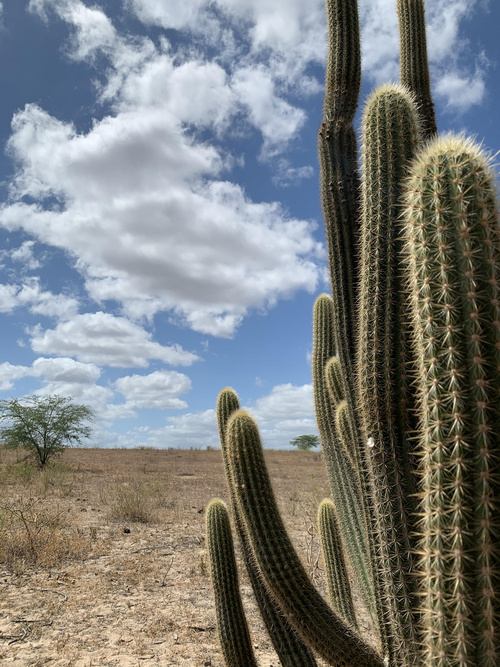
After that, the landscape becomes Disneyland, and we had a fantastic average speed throughout the day, specially from 12pm until 3pm, reaching averages above 57km/h. In the end, after flying more than 11 hours, our average speed in the whole day was around 53km/h. The wind was strong enough to let us reach a top speed when jumping mountains and its venturis as fast as 108km/h. Cloud base was above average, reaching 2000m ASL as early as 10am, and 3000m ASL in the afternoon. Thermals in sertão are usually not so strong, except in lee sides or protected triggers, as the strong wind doesn’t let the heat accumulates so much, organising the cycles and releasing average thermals of 3m/s, with peaks of 6 or 8m/s. The tracklog and all its info are in the link below:
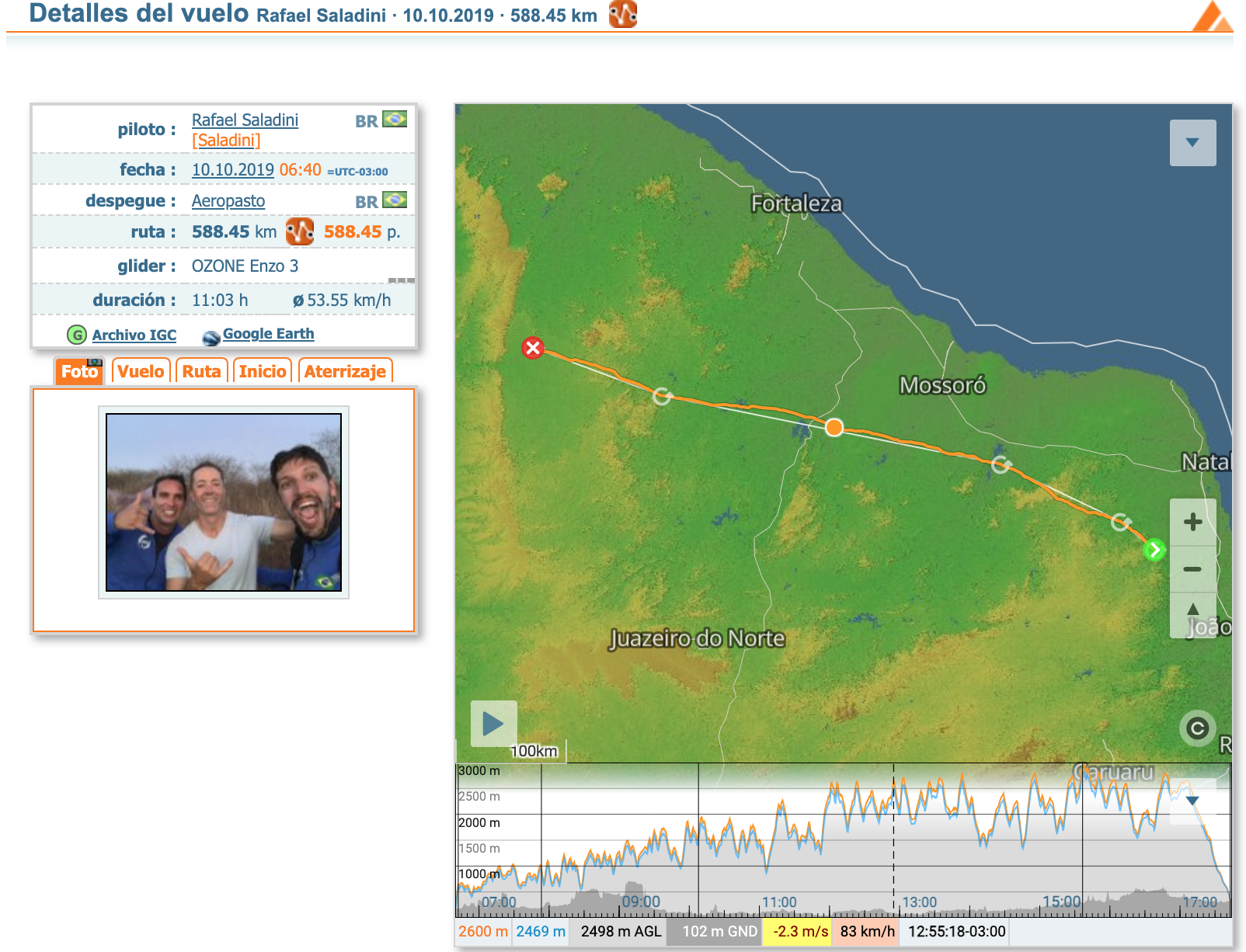
https://www.xcontest.org/2020/world/en/flights/detail:Saladini/10.10.2019/09:40
Our bets (Barros and winch), definitely paid off, but as Isaac Newton said once: “if we have seen further, it is by standing on the shoulders of giants”. Since 1996, our masters André Fleury, Marcelo Prieto and Frank Brown have been exploring the Brazilian sertão. Following the footsteps of the pioneers, a group of hang glider pilots who realised the potential of sertão in the early 90s, they were among the first paragliding pilots to explore the region.
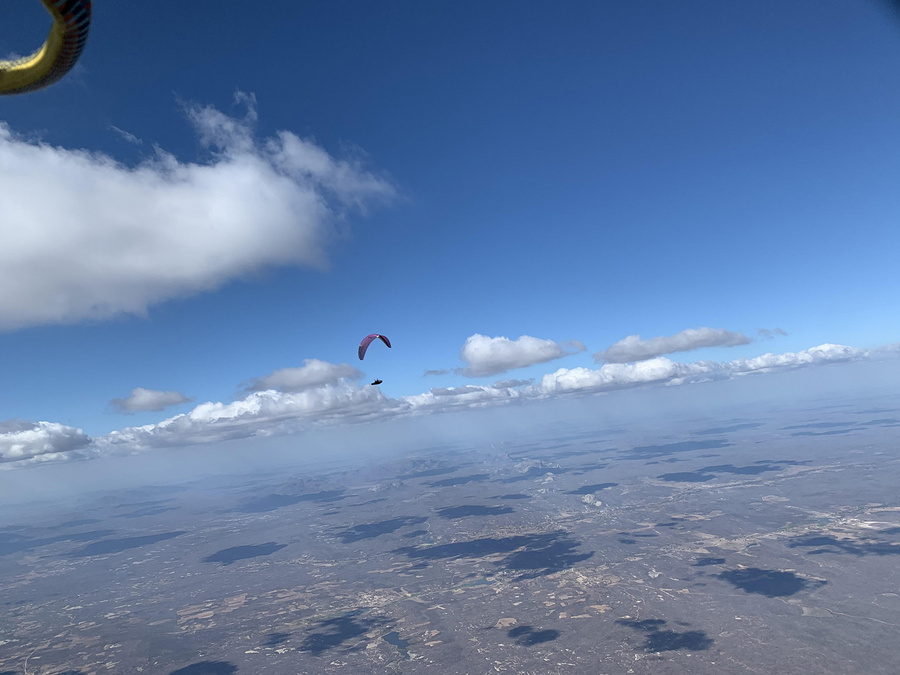
André Fleury was the first one to consider taking-off as early as 7 am. Everyone, including Frank and Marcelo, would laugh at him. In 1999, he was the first to ever break a world record in Brazil, and since then, FAI ratified all 7 multi-place world records he broke in sertão. Marcelo Prieto and he are the founders of our team - they taught us almost everything we know about that place. All that knowledge pilots are taking for granted nowadays, like launching before 6 am, flying classic routes, facing strong wind foot launches, landing throughout sunset, flying for more than 11 hours, flying as a team and so on, is the knowledge that was developed by Fleury and our team. This article is to let the paragliding community and every pilot who come to fly in sertão understand how we reached such a high level in Cross Country flying, who were the pioneers and why sertão from an ugly duck became a protagonist.
Before Fleury’s vision, which expanded for more than 10 hours the “flyable window”, pilots would fly in sertão at most 8 to 9 hours. The place was definitely the ugly duck of the four famous regions for big flights in the world. Together with Texas’ desert, the Australian outback and South African savannah, all of them in the temperate zone with more than 14 hours of daylight, sertão was the only one close to the Equator with “only” around 12 hours of daylight. Record chasers would not even consider sertão as a good option. However, after so many years studying the paragliding big flights, I should say they were miscalculating, using an incomplete equation. One main big secret of sertão is the intensity of the sun, as the amount of energy delivered to the ground is far greater in the Equator than in temperate zone, allowing us to launch as early as dawn and land as late as dusk, flying even more hours than in any other region.
Since the 90s, our team has broken 24 world records (the last one from the list below is still under review to be ratified):
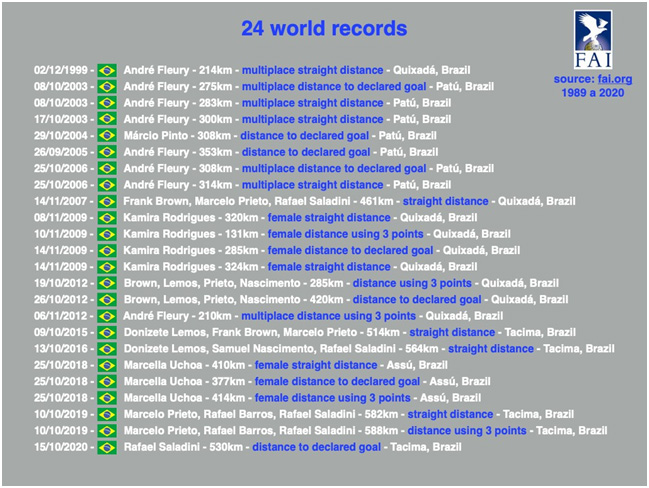
Our team is honoured to be the vanguard of Cross Country flying in the last 21 years. We are really stoked to see our work turn sertão into the most successful place for breaking paragliding world records in the world. Brazilian "sertanejos" are among the kindest and friendly human beings on planet Earth - they truly make you feel at home. When we first see them, our “urban western eyes” can only see the lack of material and ephemeral things. But when we get to know them and are invited to their homes, they open their world of simplicity, hospitality, care and love, which usually give us life lessons to face life from a different perspective.
You seem to make a special accent on winch launch. What is that about?
And talking about different perspectives, the winch opened a completely new reality for our exploration and for distance world record chasing. In my opinion, as a holder of the last two world records, 564km foot launching and 582km winch launching, FAI should better split them into two different types of records to avoid the extinction of the traditional foot launching in straight distance world record attempts. When we foot launch in extreme conditions to break a record, I assure we have several disadvantages in comparison with winch launching.
Several years ago the Swiss federation and Fly by Andy started an amazing project to break world records from the city of Caicó. They were the first ones in Brazil to adopt the winch as a strategy to increase safety and mitigate the risks. Swiss pilots could instantaneously avoid spending painful years as we did while learning how to foot launch safely. The winch was a perfect shortcut to let them be competitive since the very beginning. Their average speeds in the morning were impressive, and that pressure made us change our whole strategy and develop our own winch operation.
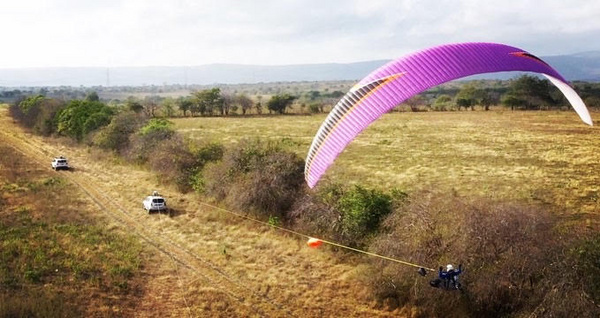
Speaking about the influence of foot and winch launch on straight distance records, first, I would like to mention an obvious difference between them that changes the whole identity of the sport. Foot launching is not only the natural traditional way of practising our sport, but it is also the basic identity of it. We are not planes or helicopters. We are not sailplanes to be self-powered or towed up. We are not powered aircraft. We are paragliders. We climb the atmosphere, only using nature. We cannot let that tradition to get extinguished. A winch is an artificial engine to bring flexibility and turn the whole process much more predictable. We can perfectly compare with surfing - paddle-in vs tow-in. It is exactly the same situation: tradition vs safety. The surfing community embraced completely the tow in the system, which is easier, flexible and predictable, however, they never let the paddle in tradition to be extinguished, as both world records are considered two completely different things. Paddle in world records are much harder and dangerous to be broken - surfers put them in another level. I would suggest FAI should do the same.
Other reasons to split them into two different world records is the winch unlimited flexibility to change the launch spot and chase conditions. We cannot move the mountain. With a winch, we can easily fabricate as many runaways as we want, wherever we want and chase the best conditions.
Foot launching can be completely unpredictable, chaotic and dangerous. We try to observe and understand the gusts and the lows, however when we pull our gliders to launch we can’t predict and be sure if whether or not a gust will catch us and blow us towards the lee. As a team, we try to launch as close as we can, however with strong gusts and the wind building up, sometimes some of us lose the day grounded at take off. With a winch, it works like a production line. It is only a matter of investing in several winches and put them to work. And of course, as we launch from flat ground, the operation is much safer as the wind is much weaker than in take-offs.
An operation based on foot launching starts much earlier. To keep ourselves within a certain safety margin we have to launch always before the wind builds up, which means get airborne just before the prediction of strong wind, that sometimes means as early as 5h15 am.
On the other hand, an operation based on winch launching can tolerate much stronger winds (+10km/h), and we can launch whenever conditions are better.
Foot launches are stressful and much more energy demanding. The fear involved affects our nights of sleep, our behaviour, our morning routine, and we relax only when we get airborne. Winch launches are comfortable and energy-efficient. We launch whenever we want and don’t get our energy drained by that overwhelming sensation of imminent danger.
We have record days with wind above 35km/h. When foot launching, we don’t have a chance and the day is gone. When winch launching we can still operate and go with the flow.
When foot launching, we have to soar the ridge for 10min to 40 min to get to cloud base. My foot-launched 572 km flight lasted 12 hours while 588km winch flight lasted 11 hours
When winch launching, in “3 to 5” minutes we disconnect with 1000m above the ground, which is higher than a typical morning cloud base of 700/800m. In my opinion, this argument is enough to separate them and bring fairness and fair play to the subject.
When foot launching, we only have one attempt and there is no time to come back to take-off and relaunch. When winch launching, we can adopt conservative procedures, like getting the first climb near the airport or a fast retrieve, to allow relaunch if needed.
Well, I see your concern. But such cases are to be discussed and decided by the CIVL Plenary.
In respect to your current ratified record do you want to mention those who helped you in your achievements?
However, what fascinates me the most is the whole journey involved that we've been through. Whether foot launching or winch launching, our achievements are amazing and I am really proud of them. Every single discovery and broken paradigm that led us to be here today writing this article for FAI about all of us. I have to thank so many people that were involved in this process.
From those anonymous pioneers that got forever forgotten and we will never know anything about them, to my masters André Fleury and Marcelo Prieto.
To my teammates Frank Brown, Donizete Lemos and Samuel Nascimento. To Sol Paragliders and Ary Carlos Pradi for sponsoring our team in crucial moments since the beginning. To Dioclécio Rosendo, Fernando Brandalize, Francisco “Choque Loc” and Mariane Neme for the incredible ground support retrieving us for more than two decades.
To our families who have been dealing with our absence, our fears and our life risks. And to Ozone Paragliders for supplying me with the Enzo 3, the best wing I ever had in my whole career.
Thank you FAI for ratifying our world records, writing our names in paragliding history and turning our adventures in sertão well known throughout the world!
I would like to invite every pilot who loves cross country flying to come to the Brazilian sertão - it definitely should be lived and experienced.
Thank you, Rafael, for sharing your experience and your passion for free-flying with us. Good luck!


